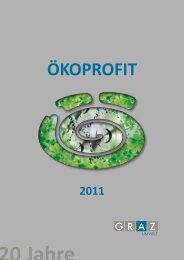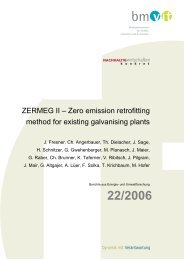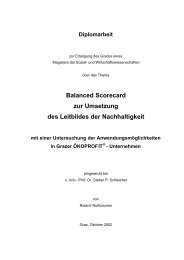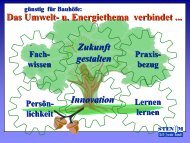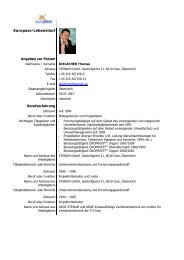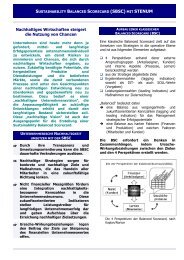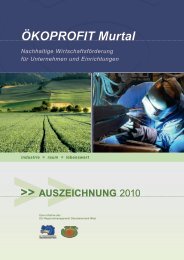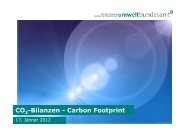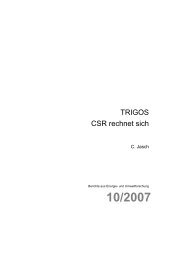Promoting Resource Efficiency in Small & Medium size ... - UNEP
Promoting Resource Efficiency in Small & Medium size ... - UNEP
Promoting Resource Efficiency in Small & Medium size ... - UNEP
You also want an ePaper? Increase the reach of your titles
YUMPU automatically turns print PDFs into web optimized ePapers that Google loves.
adequate strategies for a better use of resources. The most commonly<br />
used ones are:<br />
• Life Cycle Analysis (see Chapter 2.3)<br />
• The MIPS concept (see Chapter 2.4)<br />
6.2 WHY:<br />
Material sav<strong>in</strong>g benefits for SMEs<br />
Increas<strong>in</strong>g material efficiency br<strong>in</strong>gs a number of benefits. First, natural<br />
resources are conserved, ensur<strong>in</strong>g that the use of the most accessible and<br />
lowest-cost resources will be extended, reduc<strong>in</strong>g the cost of production,<br />
improv<strong>in</strong>g liv<strong>in</strong>g standards and ensur<strong>in</strong>g the resources will be available<br />
for future generations. While scarcity of natural resources, other than<br />
water and energy, does not appear to impose a substantial restra<strong>in</strong>t on<br />
development, conserv<strong>in</strong>g those resources does provide benefits.<br />
Second, reduc<strong>in</strong>g the demand for raw materials will reduce the impacts of<br />
raw material extraction, <strong>in</strong>clud<strong>in</strong>g both environmental and social impacts.<br />
The environmental impacts of m<strong>in</strong><strong>in</strong>g and primary process<strong>in</strong>g, <strong>in</strong><br />
particular, can be severe, <strong>in</strong>clud<strong>in</strong>g water pollution, air pollution and land<br />
degradation. Environmental regulation of m<strong>in</strong><strong>in</strong>g and primary process<strong>in</strong>g<br />
has often been less effective than regulation of large-scale <strong>in</strong>dustry and<br />
the energy sector, <strong>in</strong> part because m<strong>in</strong><strong>in</strong>g enterprises tend to be small,<br />
<strong>in</strong> some cases consist<strong>in</strong>g of one m<strong>in</strong>e. <strong>Small</strong> enterprises can disappear<br />
or declare bankruptcy after resource deposits are depleted, leav<strong>in</strong>g the<br />
damage to be cleaned up by others. In the United States, for example,<br />
many of the largest Superfund toxic waste sites are metal m<strong>in</strong>es and<br />
m<strong>in</strong><strong>in</strong>g operations produce a large share of <strong>in</strong>dustrial toxic releases. The<br />
costs of these environmental impacts are not reflected <strong>in</strong> the market prices<br />
of raw materials. Analyses have generally found that the environmental<br />
impacts of recycl<strong>in</strong>g materials are substantially less than the impacts of<br />
extract<strong>in</strong>g the same raw materials. The impacts of raw material extraction<br />
will not be exam<strong>in</strong>ed here, other than to note that <strong>in</strong>creas<strong>in</strong>g material<br />
efficiency will reduce such impacts.<br />
Third, energy will be conserved and greenhouse gas emissions<br />
reduced. As <strong>in</strong>dicated <strong>in</strong> the chapter on Energy <strong>Efficiency</strong>, the metals<br />
sector <strong>in</strong> particular is very energy <strong>in</strong>tensive. Recycl<strong>in</strong>g of materials can<br />
save most of the energy required for ref<strong>in</strong><strong>in</strong>g and process<strong>in</strong>g. Typical<br />
energy sav<strong>in</strong>gs from recycl<strong>in</strong>g relative to raw material extraction are<br />
estimated at: alum<strong>in</strong>ium 95%, iron and steel 74%, plastic 80%, paper<br />
64% and glass about 10%.<br />
Fourth, <strong>in</strong>creas<strong>in</strong>g material efficiency will reduce the amount of waste<br />
material go<strong>in</strong>g to landfills or to be <strong>in</strong>c<strong>in</strong>erated, reduc<strong>in</strong>g land use, water<br />
and air pollution and other negative impacts from waste handl<strong>in</strong>g.<br />
Industrial production and consumption are <strong>in</strong>volved <strong>in</strong> almost all solid<br />
waste disposals <strong>in</strong> developed countries, whether through wastes from<br />
extraction of <strong>in</strong>dustrial raw materials, wastes from <strong>in</strong>dustry, or household<br />
or office waste of <strong>in</strong>dustrial products. In the United K<strong>in</strong>gdom, <strong>in</strong>dustrial<br />
production and consumption account directly for almost one-third of<br />
solid waste, with m<strong>in</strong><strong>in</strong>g and quarry<strong>in</strong>g, and construction and demolition<br />
account<strong>in</strong>g about equally for most of the rema<strong>in</strong><strong>in</strong>g two-thirds. With<strong>in</strong><br />
the 33% due directly to <strong>in</strong>dustrial production and consumption, 14%<br />
is directly from <strong>in</strong>dustry, 10% is from commercial sources and 9% is<br />
household waste. Only the 5% of solid waste due to dredg<strong>in</strong>g, and a<br />
few percent due to household yard waste (leaves and grass) and food<br />
waste, is <strong>in</strong>dependent of <strong>in</strong>dustrial production. Agricultural residues are<br />
generally not <strong>in</strong>cluded <strong>in</strong> solid waste statistics, nor are livestock wastes,<br />
which are considered liquid waste.<br />
Fifth, improved collection and recycl<strong>in</strong>g of waste, particularly dr<strong>in</strong>k<br />
conta<strong>in</strong>ers and plastic bags, could reduce the amount of litter<br />
clutter<strong>in</strong>g land and water and <strong>in</strong> some cases clogg<strong>in</strong>g dra<strong>in</strong>age<br />
systems. In fact, the desire to reduce litter for aesthetic reasons has<br />
been a major driv<strong>in</strong>g force beh<strong>in</strong>d municipal recycl<strong>in</strong>g schemes <strong>in</strong><br />
many areas. 50<br />
6.3 HOW:<br />
SMEs can improve their material efficiency<br />
Material Flow Analysis 51<br />
The so-called ‘material flow analysis’ is a systematic approach aim<strong>in</strong>g at:<br />
• Present<strong>in</strong>g an overview of the materials used <strong>in</strong> a company<br />
• Identify<strong>in</strong>g the po<strong>in</strong>t of orig<strong>in</strong>, the volumes as well as the causes<br />
of waste and emissions<br />
• Creat<strong>in</strong>g a basis for an evaluation and forecast of future<br />
developments<br />
• Def<strong>in</strong><strong>in</strong>g strategies to improve the overall situation<br />
Problems of waste and emission for a company arise at those po<strong>in</strong>ts<br />
of production where materials are used, processed or treated. If a<br />
company wants to f<strong>in</strong>d a strategic solution to environmental problems,<br />
it is essential to capture the current material flows <strong>in</strong> a model to<br />
identify po<strong>in</strong>ts of orig<strong>in</strong>, volumes and causes of waste and emissions.<br />
Furthermore, <strong>in</strong> a material flow analysis the composition of the used<br />
substances is analysed, their economic value is estimated and possible<br />
future developments are forecasted. The <strong>in</strong>troduction of an <strong>in</strong>formation<br />
system will enable management to retrace material flows with<strong>in</strong> the<br />
company, to direct them and to guarantee that they are efficiently used.<br />
“A material flow analysis is a systematic reconstruction of the way a<br />
chemical element, a compound or a material takes through the natural<br />
and/or the economic cycle. A material flow analysis is generally based<br />
on the pr<strong>in</strong>ciple of physical balance.”<br />
German commission of <strong>in</strong>quiry “Schutz des Menschen und der Umwelt“<br />
– Protection of human life and the environment<br />
– of the Deutsche Bundestag, 1993<br />
The follow<strong>in</strong>g types of charts can be used for the graphical representation<br />
of a material flow analysis:<br />
a. Flowcharts represent<strong>in</strong>g material flows and process steps<br />
b. Pie charts and histograms illustrat<strong>in</strong>g ratios and compositions<br />
c. Time-travel diagrams show<strong>in</strong>g time relations<br />
d. Sankey diagrams visualis<strong>in</strong>g material flows true to scale<br />
a. b. c. d.<br />
Step 1: Draw a Materials Flowchart<br />
• Def<strong>in</strong>e the objective of the material flow analysis and the<br />
parameters to be monitored<br />
• Def<strong>in</strong>e the balance scope<br />
• Def<strong>in</strong>e the balance period<br />
• Identify and def<strong>in</strong>e process steps<br />
Def<strong>in</strong><strong>in</strong>g parameters:<br />
One of the objectives of a material flow analysis is to retrace the flows of<br />
goods and/or certa<strong>in</strong> chemical compounds or s<strong>in</strong>gle elements through<br />
the company with regard to various criteria (costs, risks, safe disposal,<br />
volumes, etc.). It is important to decide at the beg<strong>in</strong>n<strong>in</strong>g how exact this<br />
analysis will be.<br />
50) Peck, M. and Chipman, R., Industrial energy and material efficiency: What role for<br />
policies?, undated<br />
51) UNIDO, Textbook Material flow analysis, 2003<br />
57




